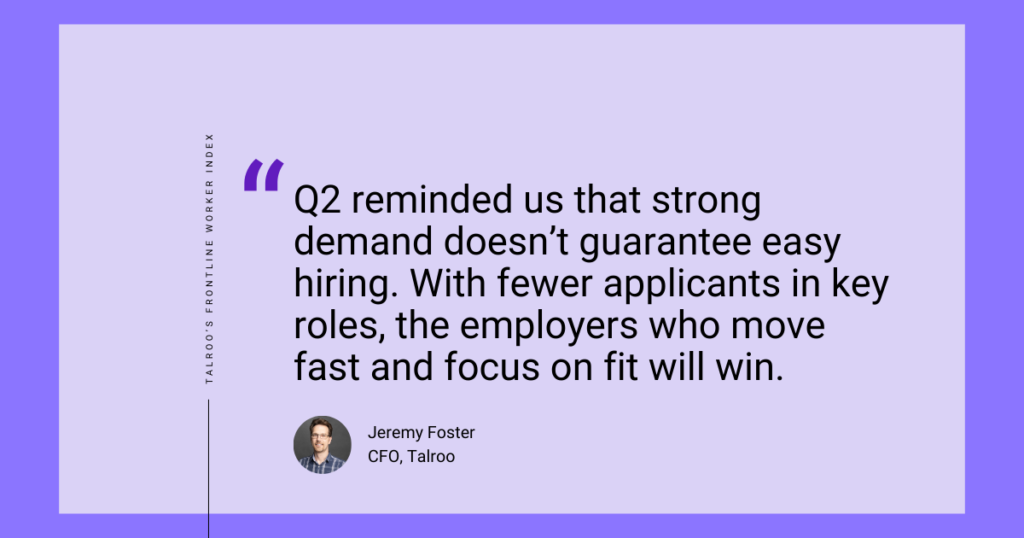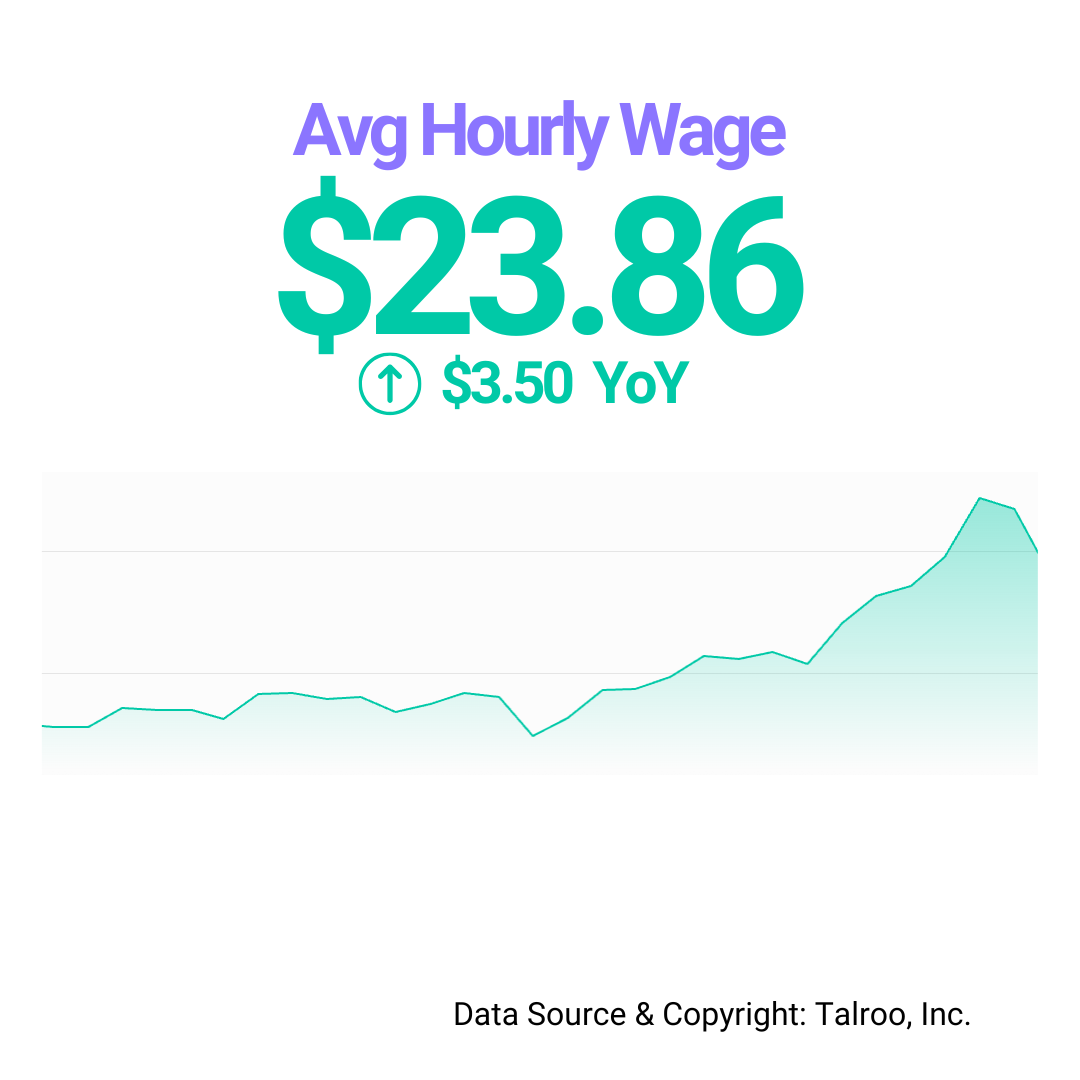Talroo's Frontline Worker Index
Frontline Worker Index: Executive summary (Q2 2025)
Steady hiring needs. Higher wages. A persistent shortage of skilled workers.
In Q2 2025, Talroo’s Frontline Worker Index adopted an enhanced methodology for several metrics. This adjustment refines our baseline and calculations, improving the accuracy of historical data.
The frontline labor market continues to show strong demand, though growth looks very different when excluding the volatility of the trucking sector. In Q2 2025, non-trucking frontline job postings reached 3,995,432, a 1% increase from Q1 2025 and a striking 33% increase year-over-year.
While trucking remains a critical industry, its rapid swings in job postings – many of which remain unfilled – create outlier data that masks underlying trends in other frontline sectors. For this reason, our Q2 aggregate job posting analyses exclude trucking: all data explorer tables still include trucking. Candidate supply continues to lag behind demand in industries such as allied healthcare, caregiving, retail, and customer service, putting ongoing pressure on employers to compete for frontline talent.
Employers are responding with higher pay and bonuses. Average hourly wages stabilized at $23.86, and average bonuses climbed to $6,251 (while there remained wide variations by industry), reflecting strong incentives to attract and retain talent in high-demand roles.
Key Trends:
- Talent Gaps Widen: Trucking and allied healthcare remain the most competitive markets, with far more postings than available resumes.
- Wage Growth: Compensation continues to outpace national averages, with frontline pay rising fastest in sectors facing acute shortages.
- Stable Full-Time Employment: Over 81% of postings are full-time, highlighting ongoing demand for reliable, long-term hires.
Frontline employers are navigating a market defined by opportunity and urgency. With wages climbing and demand strong, attracting the right talent has never been more critical – or more competitive.
Frontline Worker Index Explorer
To explore Talroo’s data and search findings for recruiting and hiring, use the Industry Explorer below. You can view nationwide trends or focus on specific states. Additionally, you can narrow your search by selecting industries or specific job titles. Happy searching!
Key Quarter-over-Quarter Trends: Q2 2025 vs Q1 2025
- Hiring Demand Stagnates: Excluding trucking, job postings rose 1% quarter-over-quarter, reaching 4 million.
- Remote Work Holds Steady: Remote-eligible roles remain limited at 2.0%, slightly down from 2.2% in Q1.
- Bonus Offers Surge: Average bonuses rose 8.6%, reaching $6,251 per role, signaling stronger employer incentives.
- Wages Stabilize at Elevated Levels: Average hourly wages slightly declined to $23.86 but remain well above historical norms.
Year-over-Year Trends (Q2 2025 vs Q2 2024)
- Job Postings Jumped 33%: The number of frontline job opportunities, excluding trucking, increased from 3.0M to 4.0M.
- Remote Options Minimal: Remote work remains uncommon, reflecting the on-site nature of most frontline roles.
- Wages Outpacing Inflation: Average hourly pay rose 17%, far exceeding the national average compensation growth of 3.8% (BLS), highlighting intense competition for talent in certain frontline industries.
Insights for Employers & Job Seekers
According to Talroo’s analysis:
- Candidates can gain a competitive edge by highlighting industry-specific skills, certifications, and schedule flexibility – especially in high-demand roles.
- Employers face heightened pressure to compete on wages, bonuses, and hiring incentives, particularly in trucking, allied healthcare, caregiving, and customer service.
- Job seekers with expertise in CDL operation, OSHA safety, caregiving, patient care, or logistics management are well-positioned to secure competitive roles in 2025.
Trucking Quarter-over-Quarter Trends: Q2 2025 vs Q1 2025
- Trucking Demand Spikes: Trucking job posts saw a spike, increasing 26% QoQ
- Trucking Resumes Lag: Despite a sharp increase in postings, trucking resumes uploaded by candidates saw a sharp 43% decrease
The Frontline Worker Index Data & Findings
The Frontline Worker Index (FWI) provides valuable data on key factors like supply and demand, job titles, wages, work schedules, education and experience requirements, and the benefits frontline workers value most. By analyzing these insights, HR professionals and recruiters can develop more effective strategies for attracting, hiring, and retaining top talent in today’s highly competitive job market.
Supply & Demand
The FWI compares new resumes and new job posts to show the balance between job seeker supply and employer demand. Important Note: In Q2 2025, the trucking industry presents a statistical outlier; exploring the data by industry will give more actionable data.
As tracked by Talroo’s Frontline Worker Index, featuring proprietary first party data in addition to Public Insight Data, the following industries had the largest mismatch between job demand and candidate supply in Q2 2025:
- Trucking
- Allied Healthcare
- Caregiving
- Customer Service
- Manufacturing
Wages & Pay
This dataset shows the average wage and sign-on bonus for jobs listed on the Talroo Ad Platform, and reflects significant regional discrepancies in states like California and New York. These states with strict salary transparency laws may skew the average wage data. In contrast, states with fewer transparency requirements remain underrepresented.
Where Wages Are Rising Fastest
Six of the top 10 frontline industries continue to outpace national average compensation growth. Notably:
- Trucking remains highly competitive, with average hourly pay at $26.09/hour, up 16% YoY.
- Warehousing/Logistics climbed to $23.86/hour, a 14% YoY increase, reflecting strong demand for skilled labor.
- Healthcare Allied Health wages rose 12% YoY, averaging $24.18/hour, driven by critical staffing needs.
- Administrative/Clerical roles increased 9% YoY, with average pay reaching $22.45/hour.
- Customer Service, Caregiving, and Retail all saw gains of 7–10%, highlighting ongoing competition for talent.
“Wages are rising faster than the national average in 6 of the top 10 frontline industries, reflecting intense employer competition for talent in high-demand sectors.”
Schedules, Hours, & Remote Work
This dataset shows the indexed Work from Home, Part-Time, and Full-Time positions listed by clients on the Talroo Ad Platform. It’s important to note that some positions may be listed as part-time or full-time based on availability or store needs, but this doesn’t necessarily affect the overall numbers.
How Schedules and Work Flexibility Are Shifting
Q2 2025 data highlights ongoing trends in employment structure and flexibility:
- Full-time roles remain dominant, accounting for over 81% of all job postings, signaling that employers continue to prioritize stable, long-term hires.
- Remote-eligible roles remain limited at 2.0%, down slightly from 2.2% in Q1 – reflecting the hands-on nature of frontline work and minimal expansion of remote options.
- Part-time opportunities remain scarce, underscoring employer preference for full-time staffing in most frontline industries.
“Frontline organizations are doubling down on full-time roles – while remote work remains rare, reflecting the on-site nature of essential work.”
Education & Experience
This index tracks Talroo clients who post jobs that do not require formal education or previous work experience. For example, roles such as warehouse workers or food service employees often fall into this category.
Explore the graphs below to see how these requirements vary by state or industry:
What’s Required: Education & Experience Trends
Q2 2025 data indicates continued movement toward inclusive hiring practices:
- Experience requirements remain steady, with many industries maintaining similar expectations year-over-year. Roles requiring no prior experience remain abundant – particularly in caregiving, food service, and warehousing.
- Educational barriers continue to decline. Many frontline postings do not require a college degree, and positions with no formal education requirement account for a significant share of openings across retail, transportation, and logistics.
- Average education level requested stayed consistent, indicating that while specialized roles still exist, overall barriers to entry are decreasing in most frontline sectors.
“Employers are wisely opening doors by emphasizing skills over degrees and experience, expanding access to frontline opportunities.”
Data Source & Copyright: Talroo, Inc.
The Frontline Worker Index Report: Methodology
Talroo processes an average of 26 million job posts every month, with over 187 million data points adding to this index directly. This extensive dataset is sourced first-party directly from Talroo, reflecting a broad spectrum of industries and geographic locations. Some job posts are comprehensive while others are less detailed; our goal is to encourage companies to be more transparent and intentional with their job posts to improve data quality and utility.
The FWI reflects information from a wide range of sectors, powered by Talroo’s robust dataset and supplemented with Public Insight Data. The report includes detailed graphs and data points, offering a clear view of how different industries are managing tight labor markets and legislative changes for frontline roles. It’s important to note that our data does not reflect all positions equally; some job posts may represent a need for one hire, while others might represent a need for 1,000.
Index numbers are based on January 2022, a point of relative stability in a post-pandemic world for frontline workers.
This set of indices is an invaluable resource for HR professionals, recruiters, business leaders, and investors seeking to understand and navigate the complex landscape of frontline and essential workforces. It provides actionable insights that can help benchmark past and current performance, as well as forecast near-term industry trends and outlook.
Frontline Worker Index Archive
View the Q1 2025 FWI Report here →
View the April 2024 FWI Report here →
View the June 2024 FWI Report here →
View the July 2024 FWI Report here →
View the August 2024 FWI Report here →
View the September 2024 FWI Report here →



